The Star Trek fictional universe contains a variety of weapons, ranging from missiles to melee. The Star Trek franchise consists mainly of several multi-season television shows and a dozen movies, as well as various video games and inspired merchandise. Many aspects of the Star Trek universe impact modern popular culture, especially its fictitious terminology and the concept of weaponry on spacecraft. The franchise has had a widespread influence on its audiences from the late 20th to early 21st century. Notably, Star Trek's science fiction concepts have been studied by real scientists; NASA described it in relation to the real world as "entertaining combination of real science, imaginary science gathered from lots of earlier stories, and stuff the writers make up week-by-week to give each new episode novelty." For example, NASA noted that the Star Trek "phasers" were a fictional extrapolation of real-life lasers, and compared them to real-life microwave based weapons that have a stunning effect.
In the fictional universe of Star Trek, the Prime Directive is a guiding principle of Starfleet that prohibits its members from interfering with the natural development of alien civilizations. Its stated aim is to protect unprepared civilizations from the danger of starship crews introducing advanced technology, knowledge, and values before they are ready. Since its introduction in the first season of the original Star Trek series, the directive has featured in many Star Trek episodes as part of a moral question over how best to establish diplomatic relations with new alien worlds.

Jonathan Archer is a fictional character in the Star Trek franchise. He is one of the protagonists of the television series Star Trek: Enterprise, where he was portrayed by Scott Bakula.
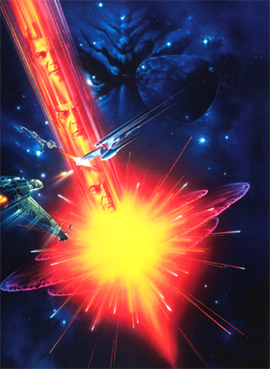
Star Trek VI: The Undiscovered Country is a 1991 American science fiction film directed by Nicholas Meyer, who also directed the second Star Trek film, The Wrath of Khan. It is the sixth feature film based on the 1966–1969 Star Trek television series. Taking place after the events of Star Trek V: The Final Frontier, it is the final film featuring the entire main cast of the original television series. The destruction of the Klingon moon Praxis leads the Klingon Empire to pursue peace with their longtime adversary, the Federation; the crew of the Federation starship USS Enterprise must race against unseen conspirators with a militaristic agenda.

Star Trek III: The Search for Spock is a 1984 American science fiction film, written and produced by Harve Bennett, directed by Leonard Nimoy, and based on the television series Star Trek. It is the third film in the Star Trek franchise and is the second part of a three-film story arc that begins with Star Trek II: The Wrath of Khan (1982) and concludes with Star Trek IV: The Voyage Home (1986). After the death of Spock (Nimoy), the crew of the USS Enterprise return to Earth. When James T. Kirk learns that Spock's spirit, or katra, is held in the mind of Dr. Leonard "Bones" McCoy, Kirk and company steal the decommissioned USS Enterprise to return Spock's body to his homeworld. The crew must also contend with hostile Klingons, led by Kruge, who are bent on stealing the secrets of the powerful terraforming device, Genesis.
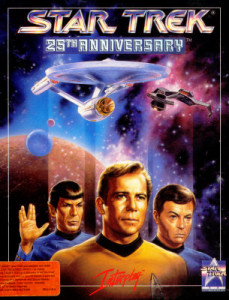
Star Trek: 25th Anniversary is an adventure video game developed and published by Interplay Productions in 1992, based on the Star Trek universe. The game chronicles various missions of James T. Kirk and his crew of the USS Enterprise. Its 1993 sequel, Star Trek: Judgment Rites, continues and concludes this two-game series.
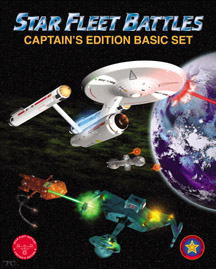
Star Fleet Battles (SFB) is a tactical board wargame set in an offshoot of the Star Trek setting called the Star Fleet Universe. Originally created in 1979 by Stephen V. Cole, it has had four major editions. The current edition is published by Amarillo Design Bureau as Star Fleet Battles, Captain's Edition.

The Gorn are a fictional extraterrestrial humanoid reptilian species in the American science fiction franchise Star Trek. They first appeared in a 1967 episode of the original series, "Arena", in which Captain Kirk fights an unnamed Gorn on a rocky planet. The fight scene has become one of the best-remembered scenes of the original series, in part due to the slow and lumbering movement of the Gorn, which some viewers have considered unintentionally comical.
"Errand of Mercy" is the twenty-sixth episode of the first season of the American science fiction television series Star Trek. Written by Gene L. Coon and directed by John Newland, it was first broadcast on March 23, 1967. It was the first episode in which the Klingons appeared.
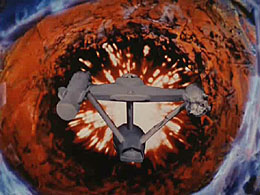
"The Doomsday Machine" is the sixth episode of the second season of the American science fiction television series Star Trek. Written by Norman Spinrad and directed by Marc Daniels, it was first broadcast on October 20, 1967.

USS Enterprise (NCC-1701-A), or Enterprise-A, to distinguish it from other vessels with the same name, is a fictional starship in the Star Trek media franchise. It made its debut in the final scene of the 1986 film Star Trek IV: The Voyage Home.
This article discusses the fictional timeline of the Star Trek franchise. The franchise is primarily set in the future, ranging from the mid-22nd century to the late 24th century, with the third season of Star Trek: Discovery jumping forward to the 32nd century. However the franchise has also outlined a fictional future history of Earth prior to this, and, primarily through time travel plots, explored both past and further-future settings.
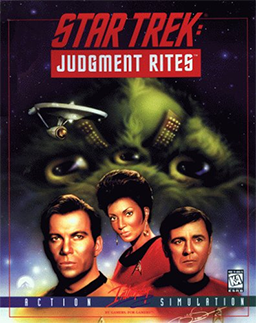
Star Trek: Judgment Rites is a computer game first produced by Interplay Productions in 1993, featuring the original cast of the classic Star Trek in a series of new adventures, including one featuring Trelane, the omnipotent child from the original episode "The Squire of Gothos". Judgment Rites uses the same MS-DOS game engine as the earlier Star Trek: 25th Anniversary; however, it had sharper graphics and sound, particularly with the CD-ROM edition. All of the initial cast members provided voices for their characters on the game in that edition. William Campbell also reprised his guest role as Trelane.
"The Immunity Syndrome" is the eighteenth episode of the second season of the American science fiction television series Star Trek. Written by Robert Sabaroff and directed by Joseph Pevney, it was first broadcast on January 19, 1968.
"Elaan of Troyius" is the thirteenth episode of the third season of the American science fiction television series Star Trek. Written and directed by John Meredyth Lucas, it was first broadcast on December 20, 1968.

Star Trek: 25th Anniversary is a 1992 adventure video game developed by Interplay and published by Ultra Games for the Nintendo Entertainment System. A different version was made with the same name on the Game Boy.
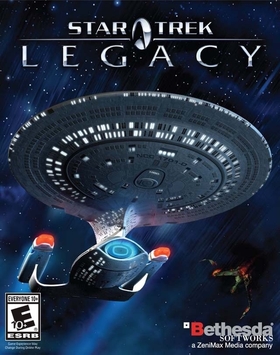
Star Trek: Legacy is a 2006 real-time tactics space combat video game for Microsoft Windows and Xbox 360 developed by Mad Doc Software and published by Bethesda Softworks in association with CBS Paramount Television and CBS Consumer Products. Originally slated for release in the fall of 2006 to coincide with the 40th anniversary of Star Trek, the Windows version was not released in North America until December 5, 2006, and the Xbox 360 version until December 15. In Europe, both the PC version and the Xbox 360 version were released on December 22, 2006.

The Ashes of Eden is a Star Trek novel co-written by William Shatner, Judith Reeves-Stevens, and Garfield Reeves-Stevens as part of the "Shatnerverse" series of novels. This is Shatner's first Trek collaboration.

Star Trek: Encounters is a video game set in the Star Trek fictional universe, which was released in 2006 for the PlayStation 2. The game was developed by Scottish studio 4J Studios for Bethesda Softworks and Ubisoft (EU).

Star Trek: The Rebel Universe is an action-adventure computer game published by Firebird Software in Europe and Simon & Schuster Interactive in America. It was originally released for the Atari ST in 1987 and was followed the next year with versions for the Commodore 64 and DOS.













